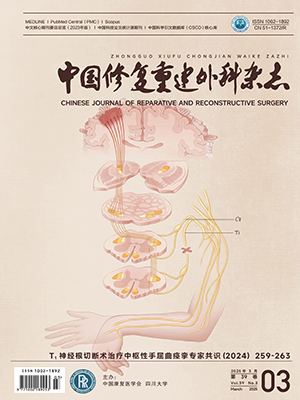Objective To compare the efficacy and indication of the three different surgical methods in the treatment of the senile osteoporotic comminuted proximal humerus fracture. Methods From January 2006 to April 2008, 70 senile patients with osteoporotic comminuted proximal humerus fracture were randomly divided into three groups to receive different surgical methods. There were 21 patients in the group A receiving Kirschner tension band or screw internal fixation, 37 patients in group B receiving internal fixation of locking proximal humeral plate, and 12 patients in group C receiving humeral head replacement. There were 36 males and 34 females aged 53-76 years old (average 61.9 years old). All the fractures
were closed, osteoporotic, and III and IV-part according to Neer classification. The disease course was 1-8 days (average 2.8 days). There was no significant difference among three groups in terms of basel ine information (P gt; 0.05). The effective antiosteoporosis therapy was given during perioperative period. Results All the incision healed by first intention. All patients reached anatomical or almost anatomical reduction without compl ications such as postoperative infection, neurovascular injury, and nonunion of bone. Seventy patients were followed up for 9-20 months (average 11.5 months). The heal ing time of the fracture was 8-12 weeks in group A and group B, the average heal ing time was 10.5 weeks in group A and 10 weeks in group B, and there was no significant difference between two groups (P gt; 0.05). Group C presented with no sign of prosthesis loosening or shoulder dislocation. Six cases in group A suffered from frozen shoulder, pain or acromion impingement syndrome 6 months after operation and obtained various degrees of improvement via functional exercises. One of them had humeral head avascular necrosis 12 months later and achieved fair recovery after performing humeral head replacement. Two cases in group B had frozen and painful shoulder 6 months after operation and achieved fair recovery after functional exercises. One cases in group C had frozen shoulder and poor performance of abduction and upl ifting and achieved improvement after exercises. The rest patients achieved satisfactory curative effects. The incidence of compl ication was 28.6% in group A, 5.4% in group B, and 8.3% in group C. The incidence of complication in group A was significantly higher than that of group B and group C (P lt; 0.05), and there was no significant difference between group B and group C (P gt; 0.05). Neer scale system was adopted to evaluate the postoperative shoulder function, the excellent and good rate was 66.7% in group A, 78.4% in group B, and 83.3% in group C. The excellent and good rate in group A was significantly less than that of group B and group C (P lt; 0.05), and there was no significant difference between group B and group C (P gt; 0.05). Conclusion The senile osteoporotic comminuted proximal humerus fracture treated by surgery can obtain satisfied results. Most patients can use locking plate fixation. Those with poor general condition can use Kirschner wire fixation with tension band or screws, but this method is subject to certain constraints. For some elder patients with humeral head necrosis and humeral head crushed, priority should be given to the use of humeral head replacement.
Citation: LIAO Chunlai,WANG Peixin,XIE Yibo,FAN Tao,LI Peihao,LIANG Weijiong.. DIFFERENT SURGICAL METHODS FOR TREATMENT OF SENILE OSTEOPOROTIC COMMINUTED PROXIMAL HUMERUS FRACTURE. Chinese Journal of Reparative and Reconstructive Surgery, 2009, 23(12): 1443-1446. doi: Copy
Copyright © the editorial department of Chinese Journal of Reparative and Reconstructive Surgery of West China Medical Publisher. All rights reserved




